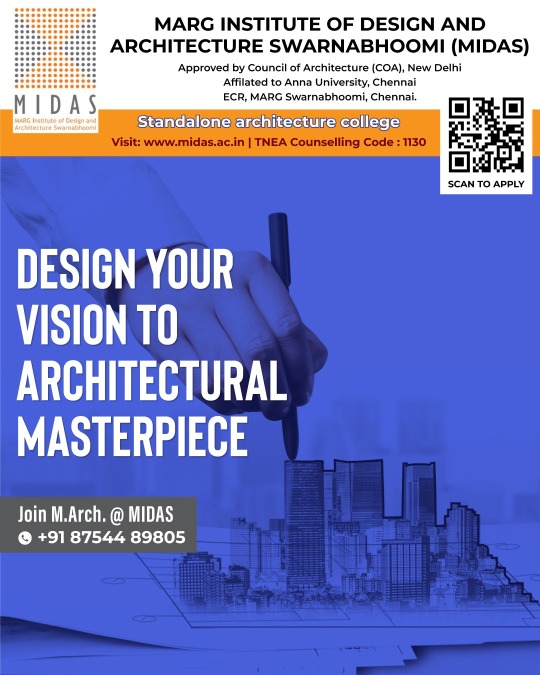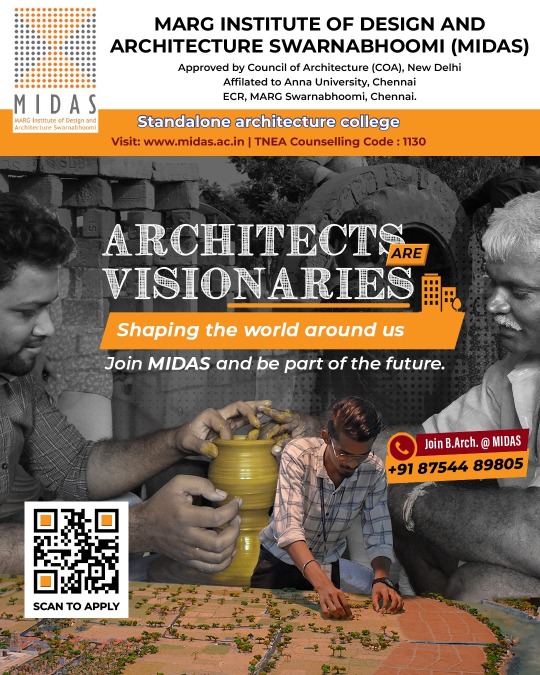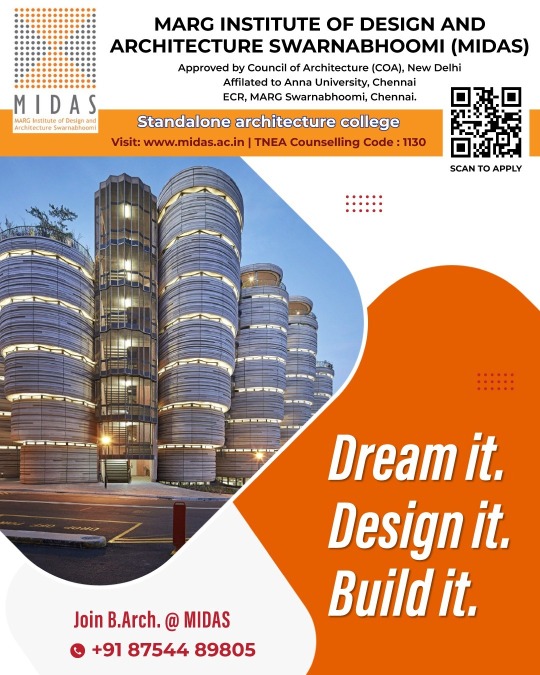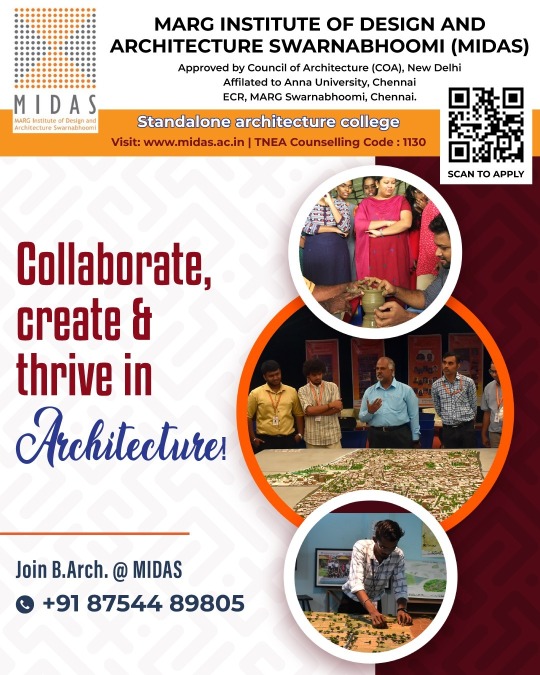Don't wanna be here? Send us removal request.
Text
MIDAS (MARG Institute of Design and Architecture Swarnabhoomi) is one of the leading Anna University affiliated colleges in Chennai for architecture. It provides a strong blend of theoretical and practical knowledge, focusing on sustainable design and innovation. With experienced faculty and industry exposure, MIDAS ensures students are well-prepared for the architectural field. The campus fosters creativity and real-world learning, helping students excel in their careers.
#colleges for architecture in india#architecture colleges in chennai#architecture institute in india#b tech architecture colleges in chennai#b arch colleges in tamil nadu
0 notes
Text
Anna university affiliated colleges in Chennai | MIDAS

MIDAS (MARG Institute of Design and Architecture Swarnabhoomi) is one of the leading Anna University affiliated colleges in Chennai for architecture. It provides a strong blend of theoretical and practical knowledge, focusing on sustainable design and innovation. With experienced faculty and industry exposure, MIDAS ensures students are well-prepared for the architectural field. The campus fosters creativity and real-world learning, helping students excel in their careers.
#colleges for architecture in india#masters degree architecture#architecture institute in india#master of architecture colleges chennai#best colleges in chennai for architecture
0 notes
Text
Discover the Power of Technology in MIDAS Architecture
In the ever-evolving world of architecture, technology has become a vital tool, transforming how architects design, plan, and construct buildings. At MARG Institute of Design and Architecture Swarnabhoomi (MIDAS), technology plays a central role in shaping the next generation of architects. With a commitment to integrating the latest advancements, MIDAS equips its students with the knowledge and tools they need to thrive in today’s digital age, making it one of the leading colleges for architecture in India.
Digital Design Tools: Elevating Creativity
One of the most exciting aspects of studying architecture at MIDAS is the opportunity to work with cutting-edge digital design software. Students gain proficiency in industry-standard tools such as AutoCAD, Revit, SketchUp, and Rhino, which allow them to create precise, intricate designs that were once only possible by hand. These tools enable them to visualize complex structures in 3D, explore various design alternatives, and collaborate effectively with peers and professionals. The integration of these technologies enhances their creativity, allowing them to push the boundaries of what’s possible in design.
Virtual Reality (VR) and Augmented Reality (AR): Bringing Designs to Life

Building Information Modeling (BIM): Streamlining the Design Process
Building Information Modeling (BIM) is another powerful technology embraced by MIDAS. BIM goes beyond traditional 2D designs by allowing students to create intelligent, 3D models that contain detailed information about the structure, materials, and systems involved in a project. By using BIM, students can simulate how their designs will perform in the real world, analyze energy efficiency, and collaborate with engineers and contractors. This technology is essential for architects to work efficiently and sustainably in the modern construction industry.
Laser Cutting and 3D Printing: From Digital to Physical
MIDAS also provides students with access to advanced fabrication tools, including laser cutters and 3D printers. These tools allow students to bring their digital designs to life through physical models, giving them a tangible understanding of scale, form, and materiality. By integrating these technologies into the curriculum, MIDAS ensures that students gain hands-on experience in every stage of the architectural design process.
Sustainability Through Smart Technology
Sustainability is at the forefront of architectural practice today, and MIDAS is committed to teaching students how to design buildings that are not only aesthetically pleasing but also environmentally responsible. Through the use of smart technology and energy simulation software, students at MIDAS learn how to create sustainable, energy-efficient buildings. These tools help them analyze the environmental impact of their designs and make informed decisions about materials, energy use, and building systems.
Preparing Future-Ready Architects
The integration of technology at MIDAS goes beyond simply teaching students how to use tools—it’s about preparing them to be future-ready architects who can lead in a tech-driven industry. With an emphasis on real-world applications and cutting-edge innovations, MIDAS equips its students with the skills they need to adapt and excel in a rapidly changing field. This commitment places MIDAS among the B.Arch best colleges in Chennai, producing architects who are well-versed in both creative design and technological proficiency.
For students aspiring to pursue higher studies, MIDAS is also one of the best Master of Architecture colleges in Chennai, providing advanced education that delves deeper into architectural theory, research, and sustainable design.
In conclusion, MIDAS stands out as a leader in architectural education, not just for its academic programs, but for its forward-thinking approach to technology. Students at MIDAS don’t just learn about architecture—they experience it through the lens of the latest technological advancements, ensuring they graduate as creative, skilled, and tech-savvy professionals ready to take on the challenges of tomorrow.
So, if you’re looking to discover the power of technology in architecture, MIDAS is the place to be—one of the top architecture colleges in chennai, shaping your future with innovation and creativity
MARG Swarnabhoomi,
Velur Village, Cheyyur Post,
Chengalpattu District,
Tamil Nadu – 603 302,
India.Phone : 044-27538010
#colleges for architecture in india#b tech architecture colleges in chennai#masters degree architecture#bachelor of architecture colleges in chennai#master of architecture colleges chennai#best colleges in chennai for architecture
0 notes
Text
MIDAS (MARG Institute of Design and Architecture Swarnabhoomi) is one of the leading colleges for architecture in india, offering both undergraduate and postgraduate programs in architecture. Known for its innovative curriculum, MIDAS emphasizes practical learning through studio-based projects and industry exposure. The campus is equipped with advanced infrastructure, creating an ideal environment for architectural creativity. Students at MIDAS are nurtured to become skilled architects, ready to meet the challenges of the real world.
#colleges for architecture in india#architecture colleges in chennai#best architecture colleges in chennai#best architecture colleges in chennai under anna university
0 notes
Text
Align your passion for design with a thriving career in architecture! Top architecture colleges in Chennai offer the perfect platform to hone your skills and shape the future.
#best colleges in chennai for architecture#colleges for architecture in india#masters degree architecture#b tech architecture colleges in chennai#bachelor of architecture colleges in chennai
0 notes
Text
From Blueprint to Reality: How AI is Transforming the Construction Process
In recent years, Artificial Intelligence (AI) has revolutionized industries across the globe, and the construction sector is no exception. What was once a slow and labor-intensive process is now becoming more efficient, precise, and innovative, thanks to AI. From the initial blueprint to the final structure, AI is transforming how buildings are designed, constructed, and maintained. Many colleges for architecture in India are also incorporating AI-driven tools in their curriculum to prepare the next generation of architects for this shift. Let’s explore how AI is streamlining the construction process, making it faster, safer, and more cost-effective.
AI in Design and Planning
At the start of every construction project, there’s a design and planning phase. This crucial step determines the project’s structure, layout, and cost. Traditionally, it’s a time-consuming process, requiring multiple revisions and intense collaboration. AI, however, is speeding things up. With AI-driven design tools, architects can input constraints such as budget, materials, and environmental factors, and the software generates optimized blueprints almost instantly. These tools offer creative solutions that might not be obvious to human designers, allowing for innovative building designs that maximize space and efficiency.
Automation on the Job Site
When it comes to construction, AI isn’t just behind a computer screen—it’s on-site, too. Automated machinery, powered by AI, is taking over repetitive and labor-intensive tasks. For example, bricklaying robots can place thousands of bricks per day with incredible precision, reducing human error and increasing speed. These AI-powered machines can work longer hours without tiring, helping to complete projects faster and with fewer workers. This doesn’t mean humans are out of the picture, but it allows skilled workers to focus on more complex tasks, improving overall site productivity.
Smarter Project Management
Managing a construction project involves juggling a lot of moving parts—schedules, materials, workers, and budgets. AI is helping project managers stay on top of these details by using predictive analytics to foresee potential delays or cost overruns. By analyzing historical data, AI can make informed predictions about project timelines and resource needs, ensuring projects stay on track. If problems arise, AI can automatically adjust schedules or recommend solutions, minimizing disruptions and keeping everything running smoothly.
Enhancing Safety on Construction Sites
Construction sites can be dangerous, with risks ranging from machinery accidents to falling debris. AI is making these environments safer. Drones equipped with AI can monitor job sites in real-time, checking for safety violations and hazards. AI systems can analyze data from past accidents and predict future risks, allowing site managers to take preventive action before problems occur. This proactive approach is reducing accidents and improving overall safety for workers.
Predictive Maintenance and Building Management
Even after a building is completed, AI continues to play a vital role. Smart buildings equipped with AI systems can monitor their own condition, flagging any potential issues such as structural weaknesses or faulty systems. This predictive maintenance allows building owners to address problems before they become major repairs, saving time and money in the long run. Additionally, AI can help manage a building’s energy usage, automatically adjusting heating, lighting, and ventilation based on occupancy, further reducing operational costs.
Promoting Sustainability in Construction
Sustainability is a growing priority in construction, and AI is helping the industry go green. By analyzing data on materials and construction methods, AI can suggest environmentally friendly alternatives that reduce waste and carbon emissions. AI also helps architects design energy-efficient buildings that use resources more sustainably, creating structures that have a lower environmental impact from start to finish.
The Future of AI in Construction
As AI continues to advance, its role in construction will only grow. In the near future, we might see fully automated construction sites where robots and AI-driven machines handle most of the physical labor, supervised by humans who manage the more complex decision-making tasks. AI will also enhance collaboration, providing real-time updates and insights to all stakeholders involved, improving transparency and communication throughout the project lifecycle.
Conclusion
AI is changing the construction industry in profound ways, from speeding up design processes to making job sites safer and more efficient. By automating repetitive tasks, optimizing project management, and promoting sustainability, AI is helping to bring construction into the future. While the industry will always need the human touch, AI is playing an essential role in turning blueprints into reality faster and smarter than ever before. As technology continues to evolve, the possibilities for innovation in construction are endless, paving the way for smarter, safer, and more sustainable building practices. Educational institutions like Anna University affiliated colleges in Chennai are preparing future professionals by integrating AI and cutting-edge technologies into their architecture programs, ensuring students are equipped for the evolving industry
MIDAS MARG Swarnabhoomi, Velur Village, Cheyyur Post, Chengalpattu District, Tamil Nadu – 603 302, India. Phone : 044-27538010
#colleges for architecture in india#architecture colleges in chennai#best architecture colleges in chennai under anna university
0 notes
Text
Discover the Artistry of Architecture: Why Pursuing an Architecture Course Could Be Your Perfect Path
Are you captivated by the artistry and beauty of the world around you? Do you find solace in the seamless blend of functionality and design? If so, a career in architecture might just be your ideal fit! Embarking on an architecture course can provide you with a solid foundation of skills and knowledge, shaping your understanding and opening doors to a world of opportunities. In this blog post by Midas India, we’ll explore the myriad benefits of pursuing an architecture course, tailored specifically for those eager to embark on this enlightening journey. Consider exploring various colleges for architecture in India to find the perfect fit for your aspirations.
Knowledge Expansion: The Gateway to Design Thinking
Engaging in an architecture course offers a comprehensive education, covering a broad spectrum of subjects including design theory, structural engineering, building materials, and urban planning. This multidisciplinary approach enables aspiring architects to develop a holistic understanding of the built environment, fostering critical thinking and innovative problem-solving. Such a foundation nurtures unique perspectives and allows students to push the boundaries of architectural design, creating groundbreaking solutions.
Cultivation of Creativity and Artistry
Architecture represents the perfect amalgamation of science and art, where creativity takes center stage. An architecture course encourages students to explore their artistic abilities and develop their distinctive design style. This creative freedom allows for experimentation with new materials, forms, and technologies while balancing function and sustainability. The fusion of artistic expression with practical problem-solving creates a fulfilling and dynamic learning experience.
Practical Skills and Hands-on Experience
Beyond theoretical knowledge, an architecture course provides ample opportunities for hands-on learning. Studio sessions, workshops, and site visits cultivate practical skills, offering a deeper understanding of architectural principles and construction techniques. Immersion in real-world projects and interaction with seasoned architects help students grasp the complexities of planning, designing, and executing architectural endeavors, ultimately preparing them for professional practice.
Enhanced Communication and Teamwork Abilities
Architecture is a collaborative field that demands effective communication and teamwork. An architecture course exposes students to group projects, fostering an environment of cooperation, idea-sharing, and healthy debate. These experiences teach students how to present their concepts effectively, listen to feedback, and work harmoniously with diverse teams—essential skills for success in the profession.
Opportunity for Global Impact and Sustainability
In today’s world, architects have a crucial role in creating sustainable and environmentally conscious solutions. Through an architecture course, students gain insights into sustainable design principles, renewable energy systems, and green architecture. This knowledge equips them to develop innovative, eco-friendly structures that minimize environmental impact, contributing positively to the global built environment.
Top Architecture Colleges: Your Path to Success
Choosing the right architecture course is key to your career. In India, top colleges like MARG Institute of Design and Architecture Swarnabhoomi (MIDAS) in Chennai offer excellent programs and facilities. These courses build technical skills, foster creativity, and enhance communication. Explore architecture colleges in Chennai to start your journey and shape a future that inspires.
#architecture colleges in chennai#best colleges in chennai for architecture#masters degree architecture#b arch colleges#colleges for architecture in india
0 notes
Text

Some of the best architecture colleges in Chennai include the School of Architecture and Planning (SAP) at Anna University, MIDAS Architecture College, and Measi Academy of Architecture. These institutions are known for their comprehensive B.Arch and M.Arch programs, blending innovative design with practical experience. Equipped with modern facilities and experienced faculty, they provide excellent training for aspiring architects. Graduates from these colleges are well-prepared to excel in the architecture profession.
#architecture institute in india#b tech architecture colleges in chennai#masters degree architecture#best colleges in chennai for architecture#colleges for architecture in india
0 notes
Text
#b tech architecture colleges in chennai#best colleges in chennai for architecture#architecture colleges in chennai#b arch colleges in tamil nadu#master of architecture colleges chennai
0 notes
Text
Climate Responsive Design: A Sustainable Solution to Conserve Energy
As the global demand for energy rises, architecture plays a pivotal role in addressing environmental challenges. One of the most promising approaches in the construction industry is climate-responsive design, which aims to create buildings that adapt to their natural surroundings, minimizing energy consumption and environmental impact. By considering local climate conditions, this design strategy offers a sustainable solution for energy conservation, and it’s becoming essential for both residential and commercial architecture. Leading institutions, including top architecture colleges in Chennai, are incorporating these principles into their curricula, training the next generation of architects in sustainable design.
What is Climate Responsive Design?
Climate-responsive design, also known as bioclimatic design, involves creating structures that interact with the environment in a way that reduces dependency on artificial heating, cooling, and lighting. The building's form, orientation, materials, and even landscaping are carefully planned to harness natural resources, such as sunlight, wind, and rain. This approach not only reduces the energy footprint but also enhances indoor comfort.
Key Principles of Climate-Responsive Design
Site Orientation and Building Shape Proper site orientation is critical in climate-responsive design. Buildings are positioned to take full advantage of natural light and ventilation. For instance, in hot climates, structures are oriented to minimize direct sun exposure, while in colder regions, they are designed to maximize heat gain from the sun. Building shape also matters—compact designs conserve heat in cold climates, whereas elongated shapes allow for better airflow in warmer regions.
Natural Ventilation By utilizing wind flow, buildings can maintain a comfortable indoor temperature without relying on air conditioning. Open floor plans, courtyards, strategically placed windows, and wind towers are common features that promote cross-ventilation, reducing the need for mechanical cooling systems.
Thermal Mass and Insulation Materials that store heat, such as concrete, brick, and stone, can absorb heat during the day and release it during cooler nights, reducing the need for artificial heating. Effective insulation, on the other hand, prevents unwanted heat transfer, keeping indoor temperatures stable and reducing the energy load for both heating and cooling.
Solar Shading Smart use of shading devices, like overhangs, louvers, and trees, helps block excessive sunlight, keeping interiors cool during the summer. These elements can be seasonally adjusted to allow sunlight in during the winter, providing passive solar heating when needed.
Green Roofs and Walls Vegetation on roofs and walls not only adds aesthetic value but also provides natural insulation, reducing the heat absorbed by buildings. Green roofs help lower urban heat island effects, reduce stormwater runoff, and contribute to biodiversity in urban areas.
Water Management Efficient water management is a core aspect of climate-responsive design. Rainwater harvesting systems, permeable pavements, and bioswales help manage water sustainably. Using water efficiently can also indirectly conserve energy by reducing the demand for water treatment and pumping.
Energy Conservation Benefits
Reduced Energy Consumption: By using natural heating, cooling, and lighting, climate-responsive buildings can significantly reduce energy usage, sometimes by up to 50%. This not only saves energy costs but also lessens the strain on the environment.
Lower Carbon Emissions: As buildings rely less on fossil fuels for energy, they contribute to reducing greenhouse gas emissions, helping combat climate change.
Increased Comfort: A well-designed climate-responsive building maintains more stable indoor temperatures, offering higher levels of comfort throughout the year without relying on energy-intensive systems.
Examples of Climate-Responsive Architecture
Indira Paryavaran Bhawan, New Delhi, India This government building has been designed to respond to the local climate using passive cooling techniques, natural lighting, and solar energy. It is India’s first net-zero energy building, designed to conserve energy and maintain a comfortable indoor environment year-round.
Casa de las Ideas, Mexico This residential building integrates climate-responsive principles with local materials, natural ventilation, and green roofs, creating a sustainable living space that adapts to the region's hot climate.
Climate-responsive design is essential for energy conservation and sustainable development. By creating buildings that adapt to their environment, we reduce reliance on artificial energy, lower carbon emissions, and enhance comfort. As climate change poses growing threats, merging design with nature becomes crucial. Top architecture colleges in Chennai are leading the way in training architects to implement these vital, eco-friendly practices.
Phone : +91 87544 89805. Email : [email protected]
MIDAS MARG Swarnabhoomi,Velur Village,Cheyyur Post,Chengalpattu District, Tamil Nadu – 603 302, India. Phone : 044-27538010
#architecture colleges in chennai#colleges for architecture in india#anna university affiliated colleges in chennai
0 notes
Text
What to do after Graduating from a Bachelors in Architecture
Graduating with a Bachelor's in Architecture is an incredible achievement, but it's only the beginning of your journey in the world of design, planning, and construction. The architecture field is vast, offering numerous opportunities to both build upon your technical skills and expand into creative and leadership roles. If you're wondering what comes next, this blog will guide you through some common and exciting pathways you can explore after earning your degree in colleges for architecture in India.
1. Pursue a Master's Degree in Architecture (M.Arch)
A Master of Architecture (M.Arch) is the most common path for those wanting to deepen their knowledge and gain expertise in a specialized field. It’s also a requirement for many advanced roles and essential if you aim to become a licensed architect in certain countries.
Advantages:
Specialization: Focus on areas like sustainable design, urban planning, interior design, or landscape architecture.
Global Opportunities: Many prestigious universities abroad offer scholarships and international exposure.
Licensure: A Master’s degree can also fulfill the educational requirements for professional licensure.
2. Get Professional Experience with an Internship or Apprenticeship
Architecture is as much a practical profession as it is theoretical. Gaining hands-on experience is crucial for building your portfolio and sharpening your skills.
Options:
Internships: Many firms offer internship programs where you can work under experienced architects.
Apprenticeships: Depending on the country, you may need to complete a mandatory apprenticeship to qualify for licensing exams.
Junior Architect Role: After graduation, you can also start as a junior architect, working your way up while learning the practicalities of construction and design.
3. Work Toward Licensure
In most countries, you cannot officially practice as an architect until you are licensed. The process usually involves:
Completing required work hours under a licensed architect.
Passing exams such as the Architect Registration Examination (ARE) in the US or Council of Architecture (COA) exams in India.
Why it’s important:
It legitimizes your status as a qualified architect.
It opens up more advanced career opportunities.
You can start your own practice.
4. Start a Career in Architectural Firms
You can join architecture firms that specialize in different types of projects, including residential, commercial, or industrial buildings.
Pros:
Learn from seasoned professionals.
Work on live projects from conception to completion.
Build a network of industry contacts that will be valuable throughout your career.
5. Explore Careers in Urban Planning
With cities expanding and more emphasis on sustainable living, urban planning has become a sought-after profession for architecture graduates. Urban planners work on creating functional, efficient, and aesthetically pleasing urban environments.
Roles include:
City planner
Transportation planner
Environmental planner
You can also pursue a Master’s in Urban Planning to delve deeper into this field.
6. Consider a Career in Construction Management
Architecture graduates are perfectly positioned to move into construction management, where they can oversee the execution of designs and ensure that projects are built according to plan, on time, and within budget.
Why consider it:
Lucrative career option.
Develop management and leadership skills.
Work closely with engineers, architects, and contractors.
7. Specialize in Sustainable Architecture
As sustainability becomes a major focus in global development, many architects are specializing in green buildings and sustainable design.
Specialization areas include:
Energy-efficient building design
Green certifications like LEED (Leadership in Energy and Environmental Design)
Renewable materials and waste reduction in construction.
Pursuing a certification or diploma in sustainable architecture can help set you apart in the job market.
8. Venture into Interior Design
If you enjoy the creative aspects of designing spaces but want to focus on interiors, then a career in interior design could be a great fit. With your architectural background, you have a competitive edge, especially in creating cohesive, functional, and aesthetic interior spaces.
9. Explore Teaching and Academia
If you’re passionate about sharing knowledge, academia could be a fulfilling career path. Many architects transition into teaching, conducting research, or contributing to architectural publications.
Options:
Become a lecturer at architecture colleges.
Pursue a Ph.D. in Architecture.
Research and contribute to the evolution of architectural theory and practice.
10. Start Your Own Architectural Practice
If you're entrepreneurial, starting your own architecture firm is the ultimate goal for many professionals. It allows you creative freedom, control over your projects, and the ability to build your brand.
Considerations:
Gain significant work experience first.
Build a portfolio to attract clients.
Understand business operations and management.
11. Explore Alternative Career Paths
If you're looking to apply your architectural skills in less traditional roles, there are plenty of industries that value your training:
Graphic design: Your eye for design and technical drawing can be valuable in digital design and branding.
Real estate: Combine your understanding of buildings with sales and development.
3D visualization/animation: Your knowledge of design software can be used in industries like film, gaming, and virtual reality.
Graduating with a Bachelor's in Architecture opens up a world of possibilities. Whether you choose to further your education, gain hands-on experience, or specialize in a specific area, the opportunities are vast and varied. The key is to align your choices with your passion and career goals. As the architecture industry constantly evolves, it’s essential to stay updated with emerging trends and commit to continuous learning. By doing so, you can build a successful and rewarding career, whether you pursue further studies in architecture colleges in Chennai or elsewhere.
#best colleges in chennai for architecture#b tech architecture colleges in chennai#b arch colleges in chennai cut off
0 notes
Text

MIDAS (Marg Institute of Design and Architecture Swarnabhoomi) is a leading choice for aspiring architects in Chennai,b arch colleges in chennai cut off with competitive B.Arch. program cutoffs. The institute maintains high academic standards and attracts top talent through its rigorous admission criteria. MIDAS offers a robust curriculum and state-of-the-art facilities, ensuring students receive a quality education in architecture. Prospective students should aim to meet or exceed the cutoff scores to secure a place in this prestigious program.
#b arch colleges in chennai cut off#bachelor of architecture colleges in chennai#b tech architecture colleges in chennai
0 notes
Text

MIDAS (Marg Institute of Design and Architecture Swarnabhoomi) is one of the leading architecture colleges in Chennai, offering comprehensive programs in both B.Arch and M.Arch. The college focuses on innovative design education, blending traditional architectural principles with modern technology. Students benefit from state-of-the-art facilities and a curriculum that emphasizes hands-on learning, sustainability, and real-world projects. MIDAS also encourages interdisciplinary collaboration and creative exploration. With a strong faculty team and industry exposure, it nurtures future architects to excel in their careers. The serene campus provides an ideal environment for focused learning and creativity.
0 notes
Text
Best colleges in chennai for architecture

MIDAS (MARG Institute of Design and Architecture Swarnabhoomi) is one of the best colleges in Chennai for architecture, known for its innovative curriculum that blends theory with hands-on experience. The institute's state-of-the-art facilities and industry collaborations provide students with a comprehensive learning environment. MIDAS is a top choice for aspiring architects seeking a creative and practical education.
#architecture institute in india#best colleges in chennai for architecture#architecture colleges in chennai
0 notes
Text

MIDAS (MARG Institute of Design and Architecture Swarnabhoomi) is a distinguished colleges for architecture in india, celebrated for its modern and holistic approach to architectural education. The institute’s curriculum emphasizes a fusion of innovative design theory and practical, hands-on experience, facilitated through real-world projects and active industry partnerships. MIDAS boasts state-of-the-art facilities, including advanced design studios and workshops, and offers both B.Arch and M.Arch programs. The serene and expansive campus fosters an ideal learning environment, supported by a faculty of seasoned professionals dedicated to nurturing future architects and leaders in the field.
0 notes
Text
https://midas.ac.in/m-arch/
0 notes
Text
colleges for architecture in india

#b arch colleges in chennai cut off#masters degree architecture#best colleges in chennai for architecture
0 notes